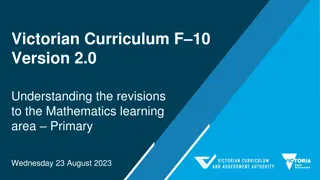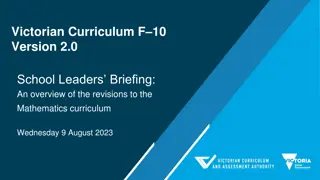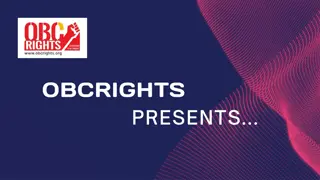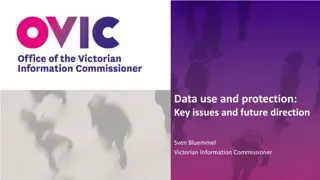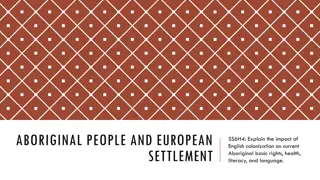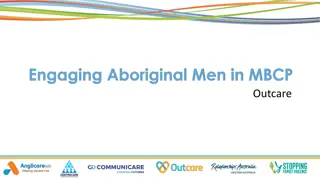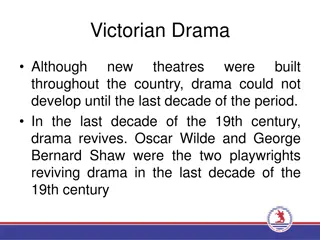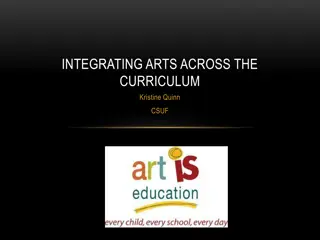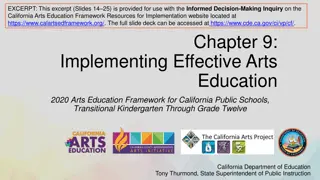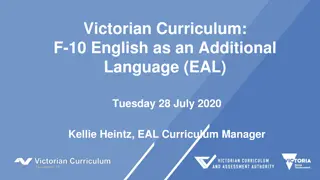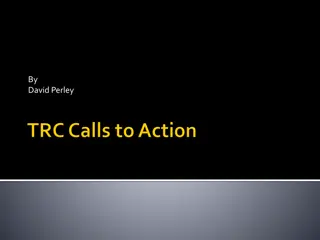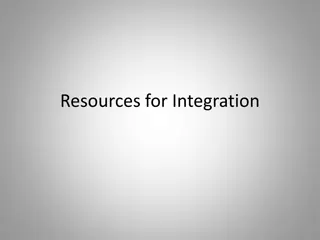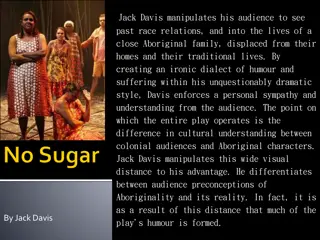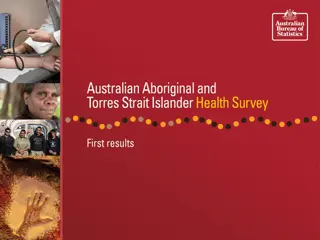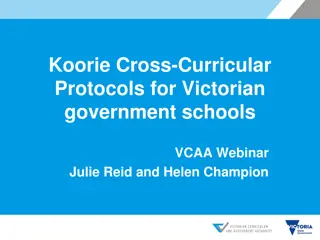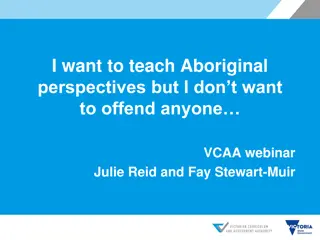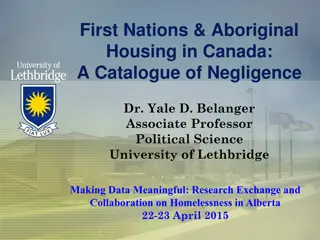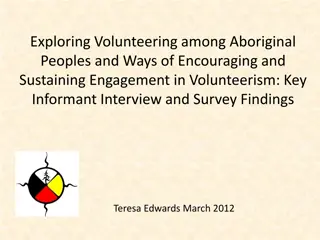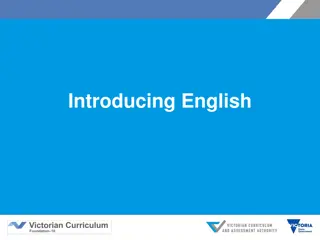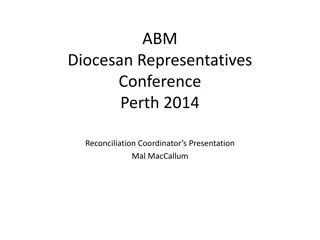Exploring Aboriginal Perspectives in Victorian Curriculum: Arts Integration
Enhance educational practices through the incorporation of Aboriginal perspectives in the Victorian Curriculum, specifically focusing on the Performing Arts and Visual & Media Arts. This integration emphasizes the importance of acknowledging traditional custodians, reclaiming indigenous culture through art forms, and fostering respect for Aboriginal and Torres Strait Islander histories and cultures.
Download Presentation

Please find below an Image/Link to download the presentation.
The content on the website is provided AS IS for your information and personal use only. It may not be sold, licensed, or shared on other websites without obtaining consent from the author. Download presentation by click this link. If you encounter any issues during the download, it is possible that the publisher has removed the file from their server.
E N D
Presentation Transcript
Making Visible Aboriginal Perspectives in the Victorian Curriculum F-10 The Arts Primary Overview of The Arts Aboriginal Perspectives Performing Arts Visual & Media Arts Protocols Resources 01-09-20
Acknowledgment of Country I would like to acknowledge the traditional custodians of the many lands across Victoria on which each of you are living, learning and working from today. I would like to acknowledge the traditional custodians of the Wadawurrung people and their ancestral lands that I am speaking to you from today. When acknowledging country, we recognise Aboriginal and Torres Strait Islander people's spiritual and cultural connection to country. We acknowledge the continued care of the lands and waterways over generations and celebrate the continuation of a living culture that has a unique role in this region. And as we share of our knowledge in teaching and learning, may we pay our respects to Elders past, present and emerging, for they hold the memories, traditions, culture and hopes of all Aboriginal and Torres Strait Islander peoples across the nation, and hope they will walk with us on our journey.
Overview of The Arts Aboriginal Perspectives
Victorian Curriculum | F-10 Overview Aboriginal Perspectives in the Curriculum Cross-curriculum priority: Aboriginal and Torres Strait Islander histories and cultures Localised and Victorian context
The Arts Overview of Content Descriptions & Elaborations The Arts Content Descriptions & Elaborations 8 Primary Dance 4 Drama 10 6 Music 10 6 Media Arts 13 6 Visual Arts Visual Communication Design 18 4 7 0
Aboriginal Perspectives in The Arts Art, song, dance for particular purpose and the use of storytelling Reclaiming and reviving of culture through the different art form practices
Overview of The Arts: Visual Arts Media Arts Kathy Hendy-Ekers | Curriculum Manager
Visual Arts F 6 Content descriptions Foundation Levels 1 and 2 Levels 3 and 4 Levels 5 and 6 Elaboration Example
Responding activity Key elements Subject matter Expression of culture or identity Investigating visual conventions (art elements and principles) Artworks as commemoration What is the meaning of the work? National Gallery of Victoria Collection Webpage Indigenous Art https://www.ngv.vic.gov.au/explore/collection/curatorial/indigenous-art/
Making and responding William Barak Figures in possum skin cloaks 1898 Pencil, wash, charcoal solution, gouache and pigments on paper 57 x 88.8 cm https://www.ngv.vic.gov.au/william-barak-figures-in- possum-skin-cloaks-1898/ Lorraine Connelly-Northey Possum-skin cloak: Blackfella road 2011-2013 Rusted iron and tin, fencing and barbed wire 268.5 x 703 cm https://www.ngv.vic.gov.au/explore/collection/work/10872 6/ Artworks have the same subject matter but are different artists from different periods of time. What are the issues that the artists are exploring in their work? Investigate the materials the artists have used. Students could create their own artwork based on their local environment using the images.
Making and responding Level 3 and 4 Explore and Express ideas The artworks could be explored unpacking the ideas behind the work as a basis for the student s own art work. The use of materials, techniques and processes could be unpacked. Visual Art Practices Students use the techniques and processes unique to either painting or sculpture. Alternative materials to the artwork could be used. Present and Perform Students unpack how the artwork is displayed. They explore the considerations of the gallery/museum and the discussions with local Aboriginal people. Students plan a presentation of their own artworks. What would they consider in the presentation?
Assessment Achievement indicators 1 Student demonstrates links between the work used for inspiration and their own artwork. 2 Student demonstrates the use of materials, techniques and visual conventions to express personal ideas in the artwork. 3 Student discusses the expression of ideas in the work of Aboriginal artists and their use of materials, techniques and visual conventions. 4 Through the presentation of their work, students discuss and evaluate the art making processes they have used and link them to the processes used by Aboriginal people.
Media Arts Exploring stories Dust Echoes - ABC Education & The Australian Teachers of Media Resource Explore the stories told in the animations. What is the purpose of the stories? Who are they for? How do these stories link to the stories told by Aboriginal people in your local community. What are the activities that the students need to do to plan an animation of a local story.
Media Arts Foundation Content descriptions Levels 1 and 2 Levels 3 and 4 Levels 5 and 6 Elaboration Example
Media Arts Key words Australian Broadcasting Corporation Production - Little J and Big Cuz Characters Settings Story principles Audience Social, cultural and historical contexts Technical elements Symbolic elements Viewpoints Media technologies This is an example of an animation made for Aboriginal and non aboriginal children to teach them about their culture. The list has some of the key elements of the Media Arts curriculum. What are some of the protocols that should be observed when discussing this production with the students?
Making and responding Level 3 and 4 Explore and Represent ideas Explore how Aboriginal people are represented in a media arts work investigating setting, ideas and story structure through sound and text. The students could plan their own story based on their study of other works. Media Arts Practices Students could use media technologies to create their own story presentation. The format could be film, a story book or photographic images. Present and Perform Students unpack the protocols regarding the display of media artworks with Aboriginal content. They consider the audience for the presentation and context in which it will be displayed. Students plan a presentation of their own media artworks. What would they consider in the presentation?
Media Arts - Representation Christian Thompson Christian Thompson Leah King Smith - Vizard Collection Untitled (Marcia Langton) 2002 Digital image 150 x 150 cm Untitled #5 (from the patterns of connection series) 1991 Direct colour composite photograph Black gum 3 (from the Australian Graffiti series) 2008 Digital image 150 x 150 cm This image is a self portrait of the artist who is Aboriginal. He is wearing a black hoodie. His face is covered by native flowers of the local area. This image is of a well known Aboriginal elder wearing a jumper with the patterning of traditional Aboriginal Arnhem land on it. The sleeves of the jumper wrap around the figure. This image is a photograph on an Aboriginal elder that has been taken from a historic slide found in the State library of Victoria. It has been superimposed by the artist over a landscape of the local area. Discuss with the students what the purpose of these images are and the techniques the artists used to make them. What is the artist trying to say? How are aboriginal people represented in the photos? Where would you find these photos? What information would you provide about them for the audience?
Assessment Achievement indicators 1 The student can describe the different representations of Aboriginal people in different media forms. 2 The student can discuss the context, content and purpose media artworks representing Aboriginal people to a specific audience. 3 Students can use intent, structure, settings, characters and media elements in a media artwork with a focus on Aboriginal people considering the cultural protocols of representation. 4 Students create a media artwork that communicates ideas about Aboriginal people and culture to an audience. They consider the purpose and context of their presentation.
Contact Kathy Hendy-Ekers Visual Arts | Media Arts| Visual Media Communication| Curriculum Manager | Curriculum Division | VCAA Kathryn.Hendy-Ekers@education.vic.gov.au
Overview of The Arts Performing Arts: Dance Drama Music Margaret Arnold | Curriculum Manager
Starting point in Performing Arts Story telling - Why do we tell stories? (https://vpsc.vic.gov.au/html-resources/aboriginal-cultural-capability- toolkit/aboriginal-culture-history) Dreamtime stories pass on the history of Aboriginal people, their relationship and spiritual connection with the land. How do we tell stories in music/ dance/ drama?
Boonwurrung Story The Filling of the Bay the time of chaos Told by Aunty Carolyn Briggs, using some Boonwurrung words. (https://cv.vic.gov.au/stories/aboriginal-culture/nyernila/) Custodians of their biik (river), traded and welcomed people from other Kulin nations and obeyed the laws of Bundjil, who travelled as an eagle, and Waang, who travelled as a crow. Conflict and chaos came, and in their arguments and fighting, the people neglected their biik. The warreeny (sea) became angry and eventually flooded the whole area. Bundjil was angry, and told the people to change their ways to save their land. The aftermath created a large bay called Nairm (we know it as Port Phillip). Bunjil, You Yangs Regional Park, Victoria
pitch rhythm form dynamics voice body movement language body action choreographic devices Music Dance Drama Storytelling
DANCE DRAMA - MUSIC Levels 3 and 4 RESPOND AND INTERPRET Identify how the elements of dance and production elements are used to express ideas in dance they make, perform and view, including in dances from local Aboriginal and Torres Strait Islander peoples (VCADAR028) DANCE (VCADAR028) Identify intended purposes and meaning of drama, including the drama of Aboriginal and Torres Strait Islander peoples (VCADRR028) DRAMA (VCADRR028) Identify features of the music they listen to, compose and perform, and discuss the purposes it was created for, including the music of Aboriginal and Torres Strait Islander peoples, using music terminology (VCAMUR028) MUSIC (VCAMUR028)
RESPOND AND INTERPRET Comparing drama in their community to drama of other people, e.g. talking with local Koorie community members about how traditional stories were told in earlier times, and how the same stories are told now DRAMA Comparing dance in local community to dances of other people, times and locations DANCE Evaluating how successfully did the group collaborate to communicate the intended ideas in the compositions? MUSIC
EXPLORE AND EXPRESS IDEAS Exploring a range of roles and situations; experimenting with tension, and creating dramatic meaning DRAMA Using devices of contrast and repetition to explore and generate new movement ideas in response to stimuli DANCE Using imagination to explore concepts, for example, lightness and weight, considering the effective use of the elements MUSIC
PRACTICES Exploring roles and situations by trialling use of language choice of words, expressions, tone DRAMA Creating short dances that communicate ideas and feeling based on response to stimuli DANCE Exploring given rhythm and pitch patterns, structures or timbres to improvise and create music MUSIC
PRESENT AND PERFORM Applying story structures in their drama, including roles and event linked through cause and effect and dramatic tension, e.g. exploring local Aboriginal stories and how they are dramatically portrayed as a reference for shaping their own drama DRAMA Using the elements of dance to communicate ideas clearly, for example, using different body shapes to represent water flowing at different speeds DANCE Planning and rehearsing their music for a live or virtual performance MUSIC
Contact Margaret Arnold Dance | Drama| Music| Performing Arts Curriculum Manager | Curriculum Division| VCAA Margaret.Arnold@education.vic.gov.au
Resources for Protocols in The Arts Koorie Cross Curricular Protocols for Victorian Government Schools (https://victoriancurriculum.vcaa.vic.edu.au/static/docs/Koorie%20Cross- Curricular%20Protocols.pdf) Principles & Guidelines Working with Koorie Community Using cultural expression in the classroom Potentially sensitive issues Advice on cross-cultural communication Indigenous cultural and Intellectual property (ICIP)
Resources for Protocols in The Arts Teaching about First Nations Content and Concepts in the DRAMA classroom. Advice for teachers in Victorian Schools. (https://ilbijerri.com.au/) Protocols working with Indigenous Artists (https://www.australiacouncil.gov.au/aboriginal-and- torres-strait-islander-arts/) Protocols for Producing Indigenous Australian: Music Visual Arts Media Arts Performing Arts Have you ever wondered about: Is it appropriate for students to perform any elements of traditional cultural practices of culture? What are some themes and concepts to teach about First Nations that students can explore?
Aboriginal Resources for The Arts Victorian Aboriginal Education Association Incorporated (VAEAI) (https://www.vaeai.org.au/documents/) VAEAI is the peak state-wide body Aboriginal community-controlled organisation and provides support and advice for education and training sector in Victoria. VAEAI provides advice, support and general resources for early years, primary and secondary schools to provide a culturally inclusive and supportive learning environment for Koorie students. Koorie Education Resources: Koorie Education Calendar Koorie Perspectives in the Curriculum Bulletins Briefs and Features But Can They Paint Dots? Protocols for Koorie Education in Victorian Primary and Secondary Schools (2016)
Aboriginal Resources for The Arts Meerreeng-an (Here Is My Country) (https://cv.vic.gov.au/stories/aboriginal-culture/meerreeng-an-here-is-my- country/) The Story of Aboriginal Victoria told through Art. Artists telling their stories through artworks and the voices from Elders and community members Story cycle of Meerreeng-an is presented in themes reflecting cultural concepts Stories reflects the cultural and historical contexts The stories and artworks reflects about Victorian Aboriginal people and culture from early 19th century to our current day.
Aboriginal and Torres Strait Islander Dance/Music Theatres Companies/Institutions Bangarra Dance Theatre (NSW) The Performing Arts, the powerful dancing and performances that interweave the art of storytelling by incorporating theatrical voice, soundscapes, music and design. E-RESOURCES Performance Performance Brolga (2001) Years 3-6 Mutton Bird (2008) Years 5/6 School Performances & workshops Teachers Professional Learnings Uniapon (2004) Years 5/6 ABOUT (2011) Years 5/6 Mathinna (2008) Years 5/6 Moth (2003) Years 3-6 Education Resources: (E-RESOURCES) Resources suitable for primary & secondary teachers to build upon the extended learning in the classroom, allows the opportunity to create discussions with students as they further explore the art of Aboriginal and Torres Strait Islander storytellingand learn about skills and techniques of movement in contemporary dance. I.B.I.S (2015) Years 3-5 Brolga (2001) Years3-6
Keep up to date Subscription services at the VCAA include: VCAA Bulletin F10 Update https://www.vcaa.vic.edu.au/Footer/Pages/Subscribe.aspx Contact Vaso at VAEAI to receive the Koorie Perspectives in the Curriculum newsletter vaso@vaeai.org.au
Contact Zeta Wilson Aboriginal Perspectives Project Manager |Curriculum Unit F-10 VCAA Zeta.Wilson@education.vic.gov.au


